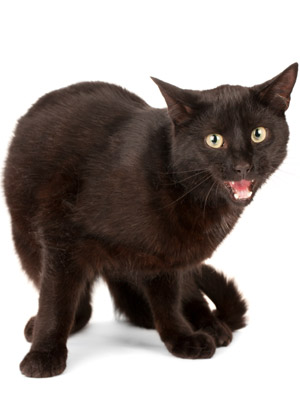Don’t be so fast to judge a cat by its color, study warns
Just like humans, domestic cats are often judged by their color, and the media and folklore help perpetuate these stereotypes. Take the snobbish, aloof, white kitty who promotes Fancy Feast cat food, and spooky images of black cats, which can be associated with bad luck and witches, especially around Halloween. A new UC Berkeley study warns that typecasting cats according to their color can negatively affect adoption rates at shelters.

October 23, 2012
Just like humans, domestic cats are often judged by their color, and the media and folklore help perpetuate these stereotypes. Take the snobbish, aloof, white kitty who promotes Fancy Feast cat food, and spooky images of black cats, which can be associated with bad luck and witches, especially around Halloween.

Black cats are often stereotyped due to superstitions
Interested in the link between how cat color influences adoption rates, a University of California, Berkeley, researcher surveyed 189 people with experience of cats as pets and found that they were more likely to assign positive personality traits to orange cats and less favorable ones to white and tortoiseshell ones. Orange cats were largely regarded as friendly, white cats as aloof and tortoiseshell cats as intolerant.
The results, published this week in the online issue of Anthrozoos, the official journal of the International Society for Anthrozoology, are noteworthy because feline typecasting can have a negative impact on adoption rates at animal shelters, the study suggests.
“To date there is little evidence that these perceived differences between differently colored cats actually exist, but there are serious repercussions for cats if people believe that some cat colors are friendlier than others,” said Mikel Delgado, lead author of the study and a doctoral student in psychology at UC Berkeley.
“We hope that this study will be a starting point for further research in what qualities affect adoption and retention of pet cats, and whether there is a genetic or physical basis (such as coat color) for personality differences in cats,” she added.
Of an estimated 100 million domesticated cats in the United States, at least one million end up in shelters each year. Many are abandoned because their personalities conflict with their owners’ expectations. A 2002 study from UC Davis found that one in four cats are brought to shelters because they did not get along with their owners or other household pets. A common complaint was that they’re “too active.” That study also found that dark cats are more likely to be euthanized, and that tortoiseshell cats are frequently typecast as having too much attitude or “tortitude.”
“Previous research supports the existence of ‘black cat syndrome,’ where black and brown cats are less likely to be adopted than cats of other colors,” Delgado said. “We were interested in whether people’s perceptions of the interaction between personality and coat color might play a part.”
To establish a link between how cat color influences adoption rates, Delgado and her co-authors used Craigslist to recruit a national sample of cat owners and cat lovers in large U.S. metropolitan areas. Participants were asked to rate, on a scale of 1 to 7, the personalities of black, white, bi-colored, tri-colored (tortoiseshell or calico) and orange cats based on their tendencies to be active, aloof, bold, calm, friendly, intolerant, shy, stubborn, tolerant and trainable.
While most people surveyed said personality informs their decision about which cat to adopt, the characteristics they ascribed to cats based on their coat color indicated that color consciously or unconsciously played a key role in their final choice of which kitty to take home.

Orange cats have a reputation of being friendly, and are very popular among cat adopters
Overall, orange cats and bi-colored cats were characterized as friendly, while black cats, white cats and tri-colored cats were regarded as more antisocial. White cats were considered to be more shy, lazy and calm, while tortoiseshell cats were more likely to be depicted as both more intolerant and more trainable. Black cats were typified as having less extreme character traits, which might contribute to their mysterious reputation.
At the Berkeley East Bay Humane Society (BEBHS), cat coordinator Cathy Marden is all too familiar with the psychology involved in pet adoptions. Staff members and volunteers there try to break down stereotypes at every opportunity, she said, and descriptions of each cat written on the adoption rooms cages highlight the individual’s characteristics.
“You can’t judge a cat by its color,” she said. “If someone comes in to adopt, we encourage them to spend time with all the cats, because it’s the personality of that cat – not the color – that will let you know if the animal’s the right fit for you.”
Still, reactions to black cats can be so strong, she said, that few adoptions take place at the shelter when there are more than a few black cats in the adoption room. “It’s a huge bummer,” said Marden, who has blogged on the BEBHS website about the “Top 10 Reasons to Adopt a Black Cat” and about the joys of adopting a monochromatic cat.
Domestic cats are believed to be descended from African wild cats and have coexisted peacefully with humans for 4,000 years. Through literature, movies and other cultural channels, cats have long been characterized as solitary, independent species who are “tolerant of affection only when it suits their needs,” according to the study. That said, cats have adapted well to a variety of living conditions, and this has made them successful at cohabiting with humans, the study points out.
Other coauthors of the study are Jacqueline Munera at the New College of Florida and Gretchen Reevy at the California State University, East Bay.